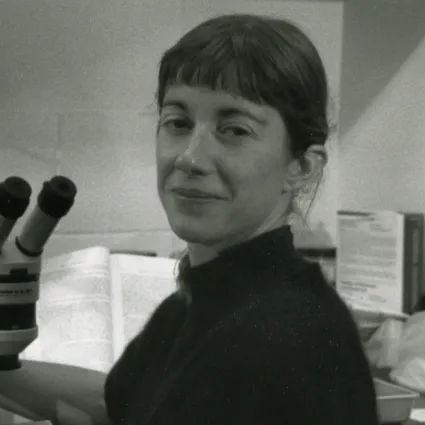Mary C. McKitrick
Laboratory Instructor

Biography
Mary McKitrick was a professor and curator of birds in the Museum of Zoology at the University of Michigan before moving to the National Science Foundation as a Visiting Program Director. While at NSF she served as a director for the following programs: Systematic Biology, Career Advancement Awards, Research Opportunities for Women, Biotic Surveys & Inventories, and Tree of Life; she was a member of the Division Director Search Committee in the Division of Environmental Biology and a member of the Research Training Grants Administration Committee. She later worked as a visiting researcher in the Department of Genetics at Harvard University and then moved with her husband and identical twin sons to Northampton. She worked at U Mass Amherst studying neurodevelopment in zebrafishes and has taught lab courses at Smith since 2002 including Genes and Genomes, Cell Biology, Research in Molecules, Cells & Systems, Biochemistry 231, Chemistry 111, and currently Biodiversity, Ecology & Conservation with a focus on bird migration. As an undergraduate and graduate student she did research on flycatchers at Manomet Bird Observatory, Powdermill Nature Reserve, and University of Michigan Biological Station; on Aimophila sparrows at Archbold Biological Station in Lake Placid, Florida, and on frugivorous bats at Santa Rosa National Park in Guanacaste Province, Costa Rica. She is currently a member of the Massachusetts Avian Records Committee (MARC).
Additional Education Details
McKitrick received a Frank M. Chapman Postdoctoral Fellowship from the Department of Ornithology at the American Museum of Natural History in New York City, a Ph.D. in Biology from the University of Pittsburgh, M.S. in Ecology and Evolutionary Biology from the University of Arizona in Tucson, and A. B. in Population Biology from Princeton University.
Publications
McKitrick, M. C. 2025. First Documented Nesting of Purple Martin (Progne subis) in Hampshire County, Massachusetts. Bird Observer 53:100-101.
Ward, D. M., R. T. Papke, U. Nübel, and M. C. McKitrick. 2002. Natural history of microorganisms inhabiting hot spring microbial mat communities: clues to the origin of microbial diversity and implications for micro- and macro-biology, p. 25-48. In J. T. Staley and A. L. Reysenbach (ed.), Biodiversity of microbial life: foundation of Earth's biosphere. John Wiley and Sons, N.Y.
Zink, R. M., and M. C. McKitrick. 1995. The debate about species concepts and its implications for ornithology: Auk. 112 701–719.
McKitrick, M. C. 1994. On homology and the ontological relationship of parts. Syst. Biol. 43:1-10.
McKitrick, M. C. 1993. Trends in the evolution of the hindlimb musculature in aerially foraging birds. Auk 110:189-206.
McKitrick, M. C. 1993. Phylogenetic constraint in evolutionary theory: Has it any explanatory power? Ann. Rev. Ecol. Syst. 24: 307-330.
McKitrick, M. C. 1992. Phylogenetic analysis of avian parental care. Auk 109:828-846.
McKitrick, M. C. 1991. Phylogenetic analysis of avian hindlimb musculature. Misc. Publ. Mus. Zool. Univ. Mich. 179:1-85.
McKitrick, M. C. 1991. Forelimb myology of loons (Gaviiformes), with comments on the relationship of loons and tubenoses (Procellariiformes). Zool. J. Linn. Soc. 102:115-152.
McKitrick, M. C. 1990. Genetic evidence for multiple parentage in kingbirds. Behav. Ecol. Sociobiol. 26:149-155.
McKitrick, M. C. 1990. Heritability of muscle size in eastern kingbirds. Condo 92:625-633.
McKitrick, M. C. and R. M. Zink. 1988. Species concepts in ornithology. Condor 90:1-14.
McKitrick, M. C. 1986. Individual variation in the flexor cruris lateralis muscle of the Tyrannidae (Aves: Passeriformes) and its possible significance. J. Zool. London(A) 209:251-270.
McKitrick, M. C. 1985. Pelvic myology of the kingbirds and their allies (Aves: Tyrannidae). Ann. Carnegie Mus. 54:275-317.
McKitrick, M. C. 1985. Myology of the pectoral appendage in kingbirds (Tyrannus) and their allies. Condor 87:402-417.
McKitrick, M. C. 1985. Monophyly of the Tyrannidae (Aves): Comparison of morphology and DNA. Syst. Zool. 34:35-45.
Recent Blog Posts
- Frequent Flyer Bird Guides: “What a new birder should know”
- Frequent Flyer Bird Guides: “On being a good eBirder”
Recent Presentations
Repopulating Purple Martins in the Pioneer Valley. Allen Bird Club, Springfield Science Museum, 6 Oct 2025